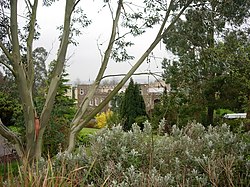Saint Hill Manor
| Saint Hill Manor | |
| Sussex | |
|---|---|
 Saint Hill Manor | |
| Location | |
| Grid reference: | TQ38243588 |
| Location: | 51°6’20"N, 0°1’37"W |
| Village: | Saint Hill Green |
| History | |
| Built 1792 | |
| By: | Benjamin Henry Latrobe |
| Late Georgian | |
| Information | |
| Owned by: | Church of Scientology |
Saint Hill Manor is a country manor house at Saint Hill Green, near East Grinstead in the northernmost parts of Sussex, two miles from the border of Surrey to the north.
The house was built in 1792 for Gibbs Crawfurd[1] and had several notable owners, until it was bought by the American science fiction author L. Ron Hubbard: it became the British headquarters of the Church of Scientology which he founded.
The house is a Grade II listed building.[1]
Early history
Saint Hill Manor was built by Gibbs Crawfurd in 1792, situated on 59 acres of landscaped gardens overlooking the hills of the High Weald. A number of archaeological artefacts in the immediate area have been attributed to the existence of a small priory or early 17th-century dwelling on the site. The original name, Sinta Hill, is thought to have come from the local Roman occupation and later Mediæval iron-workings found throughout the area.
Subsequent owners included Edgar March Crookshank and Mrs. Drexel Biddle, who commissioned the famous Monkey Mural which was painted by John Spencer-Churchill, nephew of Sir Winston Churchill. It was once owned by William Thomas Berger and in the late 1800s served as the headquarters of the China Inland Mission. Hudson Taylor and Berger met there often and it was a centre for training recruits for the mission field.
L. Ron Hubbard purchase

L. Ron Hubbard, the founder of the Scientology organisation, bought the mansion from Sawai Man Singh, the Maharajah of Jaipur, in 1959 after meeting at a casino in London. The Maharaja needed to settle his gambling debts. Hubbard claimed in a subsequent lecture that he purchased the property for £58,000. He lived there with his family until early 1966 before moving abroad.
Under Hubbard's ownership, the manor was extensively modified, with a series of extensions and new buildings constructed on the estate during the 1960s, 1970s and 1980s to accommodate the training facilities and attendant administration functions. The largest is a mock-Norman castle built adjacent to the main manor house after 1968 to provide a purpose-built training facility for Scientology followers. The council initially refused planning permission. After a public enquiry, however, the Church of Scientology was granted permission to go ahead with the construction of "Saint Hill Castle".[2]
Saint Hill Manor served as Hubbard's organisational headquarters until 1967.
2015 renovations
The Scientologists' renovations on the Saint Hill Manor were completed in the summer of 2015 and are reported to have cost a total of US$16 million. The organisation claims that they are preserving it as a “historic monument.” Saint Hill Manor is now a museum that features the works of L. Ron Hubbard, and exhibits about what the Scientology organisation claims are his accomplishments.[3]
Outside links
| ("Wikimedia Commons" has material about Saint Hill Manor) |
- Saint Hill Manor
- Advanced Organization & Saint Hill United Kingdom (official home page)
- Saint Hill Manor (AboutBritain.com)
References
- ↑ 1.0 1.1 National Heritage List 1249037: Saint Hill Manor (Grade II listing)
- ↑ Rolph, C.H. (1973). Believe What You Like: What Happened Between the Scientologists and the National Association for Mental Health. Andre Deutsch Limited. pp. Chapter 6: Scientologists and the Law I [1]. ISBN 0-233-96375-8.
- ↑ Lewis, J. (2017). Lewis, James R.; Hellesoy, Kjersti. eds. Handbook of Scientology. Brill Handbooks on Contemporary Religion. Brill. ISBN 9789004330542.
